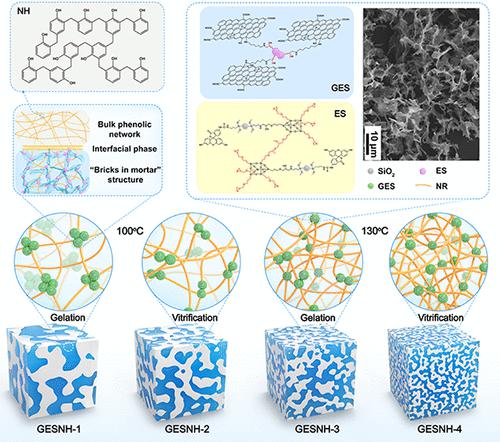当前位置:
X-MOL 学术
›
Ind. Eng. Chem. Res.
›
论文详情
Our official English website, www.x-mol.net, welcomes your
feedback! (Note: you will need to create a separate account there.)
New Strategy to Construct Mechanically Strong and Tough Phenolic Networks by Considering the Effect of Curing Reactions and Physical States on the Cross-Linking Density and Cross-Linking Inhomogeneity
Industrial & Engineering Chemistry Research ( IF 3.8 ) Pub Date : 2022-06-18 , DOI: 10.1021/acs.iecr.2c01189 Zixuan Lei 1 , Zhongzhou Zhang 1 , Jian Wang 1 , Li Xu 1 , Jian Li 2 , Zhichao Zhu 3 , Yuhong Liu 1
Industrial & Engineering Chemistry Research ( IF 3.8 ) Pub Date : 2022-06-18 , DOI: 10.1021/acs.iecr.2c01189 Zixuan Lei 1 , Zhongzhou Zhang 1 , Jian Wang 1 , Li Xu 1 , Jian Li 2 , Zhichao Zhu 3 , Yuhong Liu 1
Affiliation

|
How to regulate the conflicting effect of cross-linking density and cross-linking inhomogeneity on the mechanical properties of a thermosetting polymer is of great scientific significance and the key to realizing high mechanical strength and toughness. Herein, a new regulation strategy for the inhomogeneous cross-linking networks is proposed from the viewpoint of curing reactions and physical states. Here, a reactive graphene oxide aerogel (GES) was prepared and employed to modify the hierarchical microstructure of phenolic resin (GESNH). The analysis of curing behavior, DMA, and DQ 1H NMR revealed that all GESNH samples possess similar cross-linking networks with like biomimetic “bricks in mortar” structure of a low cross-linking density, bulk phenolic networks, and an interfacial phase with a high cross-linking density but with diversely tuned cross-linking density and cross-linking inhomogeneity. As for GESNH cured at 130 °C or that reached the vitrification state in the first curing stage, the volume fraction of the interfacial phase was increased and the “bricks in mortar” structure was decreased, thus increasing cross-linking density and decreasing cross-linking inhomogeneity, compared with GESNH cured at 100 °C or that reached the gelation state. As a result, a higher cross-linking density and lower cross-linking inhomogeneity of the former can facilitate load transfer and restrict chain segment mobility, resulting in improved flexural and tensile strength but decreased ε and KIC. Notably, the flexural strength, tensile strength, ε, and KIC of GESNH-3 were increased by 23.16, 45.85, 82.99, and 102.30% compared with those of GNH, respectively.
中文翻译:

考虑固化反应和物理状态对交联密度和交联不均匀性的影响,构建机械强韧酚醛网络的新策略
如何调节交联密度和交联不均匀性对热固性聚合物力学性能的矛盾影响具有重要的科学意义,是实现高机械强度和高韧性的关键。在此,从固化反应和物理状态的角度提出了一种新的非均匀交联网络调控策略。在这里,制备了反应性氧化石墨烯气凝胶(GES)并用于改性酚醛树脂(GESNH)的分级微观结构。固化行为、DMA 和 DQ 1的分析H NMR 表明,所有 GESNH 样品都具有相似的交联网络,具有低交联密度的仿生“砂浆砖”结构、块状酚醛网络和具有高交联密度但具有多种调谐交联的界面相- 连接密度和交联不均匀性。对于在 130 ℃固化或在第一个固化阶段达到玻璃化状态的 GESNH,界面相的体积分数增加,“砂浆中的砖”结构减少,从而增加了交联密度,降低了交联度。与在 100°C 固化或达到凝胶状态的 GESNH 相比,连接不均匀性。因此,前者较高的交联密度和较低的交联不均匀性可以促进负载转移并限制链段的移动性,ķ集成电路。值得注意的是,与 GNH 相比,GESNH-3的抗弯强度、抗拉强度、ε 和K IC分别提高了 23.16、45.85、82.99 和 102.30%。
更新日期:2022-06-18
中文翻译:

考虑固化反应和物理状态对交联密度和交联不均匀性的影响,构建机械强韧酚醛网络的新策略
如何调节交联密度和交联不均匀性对热固性聚合物力学性能的矛盾影响具有重要的科学意义,是实现高机械强度和高韧性的关键。在此,从固化反应和物理状态的角度提出了一种新的非均匀交联网络调控策略。在这里,制备了反应性氧化石墨烯气凝胶(GES)并用于改性酚醛树脂(GESNH)的分级微观结构。固化行为、DMA 和 DQ 1的分析H NMR 表明,所有 GESNH 样品都具有相似的交联网络,具有低交联密度的仿生“砂浆砖”结构、块状酚醛网络和具有高交联密度但具有多种调谐交联的界面相- 连接密度和交联不均匀性。对于在 130 ℃固化或在第一个固化阶段达到玻璃化状态的 GESNH,界面相的体积分数增加,“砂浆中的砖”结构减少,从而增加了交联密度,降低了交联度。与在 100°C 固化或达到凝胶状态的 GESNH 相比,连接不均匀性。因此,前者较高的交联密度和较低的交联不均匀性可以促进负载转移并限制链段的移动性,ķ集成电路。值得注意的是,与 GNH 相比,GESNH-3的抗弯强度、抗拉强度、ε 和K IC分别提高了 23.16、45.85、82.99 和 102.30%。











































 京公网安备 11010802027423号
京公网安备 11010802027423号